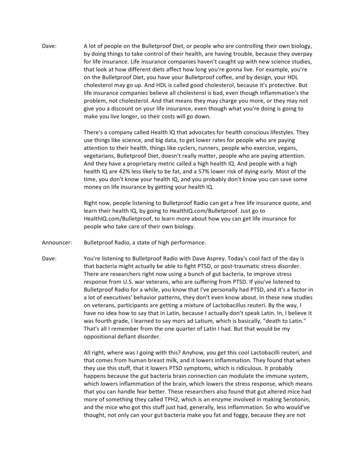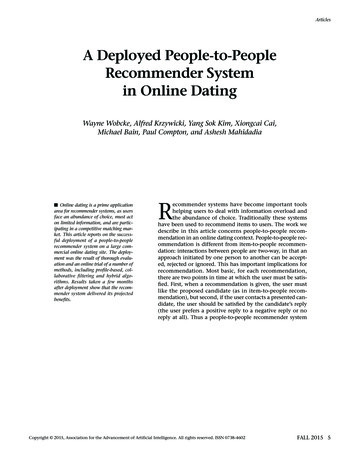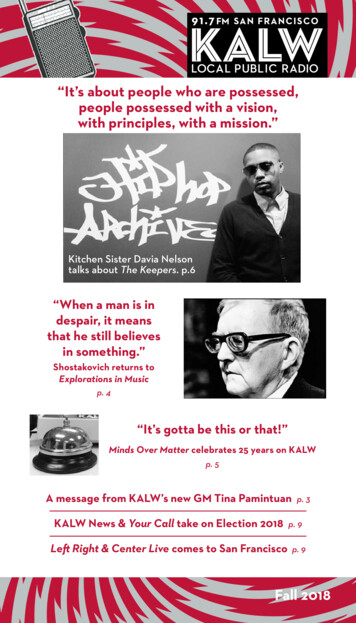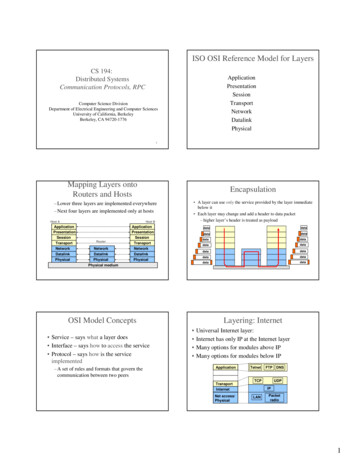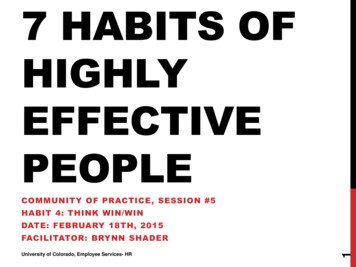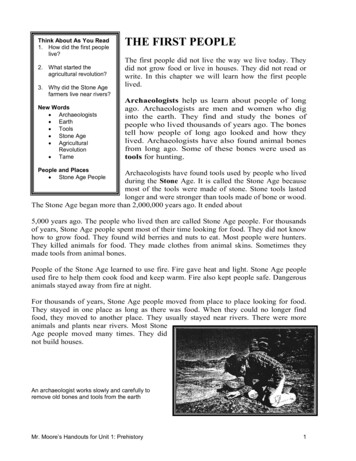
Transcription
Think About As You Read1. How did the first peoplelive?2. What started theagricultural revolution?3. Why did the Stone Agefarmers live near rivers?New Words Archaeologists Earth Tools Stone Age AgriculturalRevolution TameTHE FIRST PEOPLEThe first people did not live the way we live today. Theydid not grow food or live in houses. They did not read orwrite. In this chapter we will learn how the first peoplelived.Archaeologists help us learn about people of longago. Archaeologists are men and women who diginto the earth. They find and study the bones ofpeople who lived thousands of years ago. The bonestell how people of long ago looked and how theylived. Archaeologists have also found animal bonesfrom long ago. Some of these bones were used astools for hunting.People and Places Stone Age PeopleArchaeologists have found tools used by people who livedduring the Stone Age. It is called the Stone Age becausemost of the tools were made of stone. Stone tools lastedlonger and were stronger than tools made of bone or wood.The Stone Age began more than 2,000,000 years ago. It ended about5,000 years ago. The people who lived then are called Stone Age people. For thousandsof years, Stone Age people spent most of their time looking for food. They did not knowhow to grow food. They found wild berries and nuts to eat. Most people were hunters.They killed animals for food. They made clothes from animal skins. Sometimes theymade tools from animal bones.People of the Stone Age learned to use fire. Fire gave heat and light. Stone Age peopleused fire to help them cook food and keep warm. Fire also kept people safe. Dangerousanimals stayed away from fire at night.For thousands of years, Stone Age people moved from place to place looking for food.They stayed in one place as long as there was food. When they could no longer findfood, they moved to another place. They usually stayed near rivers. There were moreanimals and plants near rivers. Most StoneAge people moved many times. They didnot build houses.An archaeologist works slowly and carefully toremove old bones and tools from the earthMr. Moore’s Handouts for Unit 1: Prehistory1
Stone Age people sometimes lived in caves. They builtfires in their caves to keep warm. Some people knewhow to paint pictures. They made pictures on the wallsof their caves. We can learn more about Stone Agepeople from the pictures they painted.After thousands and thousands of years, Stone Agepeople learned how to grow their own food. This wasthe start of the agricultural revolution. The agriculturalrevolution was a change in the way people got theirfood. People learned to plant seeds to grow fruits and vegetables for food.People became farmers. As time passed, they grew more and more food. Sometimesthey grew enough food to feed wild animals. People began to tame dogs, goats, sheep,and cows. Some of these animals helped families with their work. Sometimes peoplekilled the animals for food.The agricultural revolution changed the lives of Stone Age people. Stone Age farmersdid not have to move from place to place to hunt animals. They could live in one place.They lived on small farms. Some people built small mud houses on their farms.Sometimes people built their homes close together in small villages. Then they couldwork together and learn from each other.Stone Age farmers needed water to grow food.Many times there was not enough rain. Farmers began to buildtheir farms near rivers. They used river water to grow food.As time passed, Stone Age people learned better ways to growfood. They made better stone tools. Stone Age people did notknow how to make metal tools. They did not know how to read orwrite. After many years people in some parts of the world began todo these things. You will read about some of these people in thenext chapters.Mr. Moore’s Handouts for Unit 1: Prehistory2
USI G WHAT YOU LEAR EDUsing VocabularyChose the word or words in bold to best complete each sentence. Write the word or words onthe correct blank line.TamedToolsArchaeologistsAgriculturalStone Age1. Men and women who study old bones to learn about people of long ago are called.2. Stone Age were items that were used for hunting orfarming.3. The was a period of millions of years in which mostpeople used stones or animal bones to make tools.4. The revolution was a change in the way Stone Age people gottheir food.5. Stone Age farmers wild animals by giving themfood to make them less afraid.Read and RememberWrite the Answer Write one or more sentences to answer each question.6. When was the Stone Age?7. How did the Stone Age people use the animals they killed?8. How did fire help Stone Age people?9. Why did Stone Age people start their farms near rivers?Mr. Moore’s Beginnings of Ancient Civilizations3
UnderstandingContinents and OceansWe live on the planetEarth. Earth has largebodies of land calledcontinents. There areseven continents. Earthalso hasfourlargebodies of water calledoceans. The four oceansseparate some of thecontinents. Look at themap.On a separate sheet ofpaper,listthefouroceans and the sevencontinents.Then answer each question below.1. Which two continents do not touch any other continents?2. Which ocean separates Africa and Australia?3. Which five continents have coasts along the Atlantic Ocean?Using Map DirectionsThe four main directions are north, south, east, and west. On maps these directions are shown by acompass rose. The compass rose shortens the directions to N, S, E, and W. Study the map above. Findthe compass rose. Then finish each sentence with north, south, east, or west.4. South America is of Antarctica.5. Africa is of Europe.6. The Pacific Ocean is of Asia.7. North America is of the Atlantic Ocean.Journal WritingWrite a short paragraph that tells how the agricultural revolution changed the lives of Stone Agepeople.Mr. Moore’s Beginnings of Ancient Civilizations4
Learning about the PastScientists believe that people have livedon earth for about 2 million years. Duringmost of that time, people left no writtenrecords about themselves. That is becausepeople did not develop writing until about5000 years ago.Scientists call the period before peoplelearned to write prehistoric times. How do scientists learn about lifeduring prehistoric times?How do scientists find theage of prehistoric remains?What does prehistoric art tell usabout the people of long ago?Key Words You will be using thesewords in this chapter.anthropologistartifactarchaeologisttheoryA prehistoric artist carved this bison, or wild ox,over 9000 years ago. Prehistoric people huntedbison for foodDetectives of the PastPrehistoric people left no writings aboutthemselves. So how do we know anythingabout them?Archaeologists are scientists who studyevidence, or clues, from the past. Some ofthose clues are objects that people made,such as tools and weapons. Other cluesare the bones of human beings andanimals.Archaeologists are like detectives: Theycarefully study each "clue" they find. Thenthey develop theories, or explanations,about prehistoric people and the ways theylived.The places where archaeologists findancient objects and bones are calledarchaeological sites.Many sites areplaces where prehistoric people lived orburied their dead.Some sites are found above ground.But most sites are buried deepunderground.Archaeologistsmustexcavate, or dig, to uncover those sites.Excavations often take many years andcost millions of dollars.Archaeologists have excavated ancientcamp sites, burial grounds, and entirevillages in Europe, Asia, Africa, and theAmericas.Looking Back1. How do archaeologists learn aboutprehistoric people?2. What are archaeological sites?3. Thinking Deeper: Why do you thinkmanysitesareburieddeepunderground?Mr. Moore’s Beginnings of Ancient Civilizations5
Clues to the PastArchaeologists answer such questions bystudying prehistoric artifacts.Here'sanexampleofhowarchaeologists use artifacts to learn aboutthe past: At Terra Amata, France, anarchaeologist excavated a prehistoriccamp site. He found the remains of twighuts covered with animal skins. Inside thehuts were stone tools. That discovery andothers like it told scientists that peoplemade stone tools thousands of years ago.At other sites in Europe. Africa, andAsia,archaeologistsfoundmoreprehistoric remains. They found stonetools and tools made out of bone. Theyalso found arrowheads and spearheadsmade out of stone and ivory. (People getivory from the teeth and tusks ofelephants, walruses, and other animals.)In some places, archaeologists foundbracelets and necklaces made out ofshells, fish bones, and ivory. What do youthink archaeologists learned aboutancient people from those artifacts?Archaeologists discovered this tomb in CentralAmerica, but was a burial place of a peoplecalled the Mayas. They lived over a thousandyears ago. What do you think archaeologistscan learn about the Mayas from the tomb?Archaeologists have even found bonesthat show evidence of operations donewith stone knives. They were surprised tolearn how much some prehistoric peopleknew about surgery.Animal bones also help archaeologistslearn about prehistoric life. Often animalbones are found near camp sites. Thattells archaeologist that prehistoric peopleprobably used those animals for food.1. What kinds of tools did prehistoricpeople use?Bones Tell a StoryAncient bones are another importantclue to the past. Archaeologists canmeasure bones and skeletons, andestimate, or guess, the size of prehistoricpeople. Archaeologists can also learnabout the shape of prehistoric people'sjaws, heads, arms, and legs from bones.Mr. Moore’s Beginnings of Ancient Civilizations2. What kinds of weapons did theymake?6
Dating Bones and ArtifactsIt is 1972. Richard Leakey, a Britishanthropologist, is looking for artifacts andbones at sites in Kenya, Africa.Near Lake Turkana, Leakey discoverspieces of an ancient human skull. Later,scientists date, or find the age of,Leakey's discovery. They estimate thatthe pieces are the remains of a humanbeing who lived nearly 2 million yearsago. Those are the oldest human remainsever found.Carbon-14 DatingArchaeologists use many differentmethods to date artifacts and bones.One method the scientists use iscarbon-14 dating. A chemist namedWillard Libby developed the method inthe late 1940s. The carbon-14 method isused to date human remains and theremains of plants and animals.Carbon-14 dating works this way: Allliving things absorb, or take in, somethingcalledcarbon-14. When a living thingdies, its remains begin to lose carbon-14at a certain rate. When scientists find theremains, they measure how muchcarbon-14 is left. Then they can tell howold the remains are.Carbon-14 dating can date remains asfar back as 50,000 years. It cannot tell theexact age, but it can tell the age within afew hundred years.Tree-Ring DatingA method for dating an artifact made ofwood is tree-ring dating. Tree-ring datingworks this way: Scientists learn the age ofthe trees in the area where, the artifactwas found. They do that by counting thetrees' rings. (Each year a tree forms anew ring.)Mr. Moore’s Beginnings of Ancient CivilizationsAnthropologist Richard Leakey and an assistant lookfor human remains near a lake in Africa. Scientistsoften took for the remains of ancient people nearlakes, rivers, and streams.Scientists then study the pattern of thetree rings. (A tree forms its rings in acertain pattern. For example, tree ringsgrow thicker in wet years.) Scientistsmatch the pattern with the pattern of ringsin the artifact. Then they know the age ofthe artifact.Tree-ring dating gives an almost exactage for artifacts made of wood. But it canonly date objects as far back as about8000 years.Looking Back1. How do artifacts help archaeologistslearn about prehistoric life?2. What can archaeologists learn fromancient bones?3. What did Richard Leakey discover?4. What are some ways scientistsdate bones and artifacts?7
This wall painting from Lascauxcave shows a bison and wildhorses.Prehistoricpeoplemade the painting over 16.000yearsago.Whatcanarcheologists learn about life inancient times by studying suchpaintings?Prehistoric ArtIn September 1940, four teenage boysmade an important discovery by accident.The boys were hunting in Lascaux woods inFrance. They came upon a hole in theground that seemed to be the opening to alarge cave.'Later, the boys climbed down andexplored the cave. They used lanterns tolight their way. They were amazed at whatthey saw. On the walls of the cave werepaintings of large animals —deer bulls,oxen, horses, even a rhinoceros. Onepainting showed a bison killed by a spear.News of the boys' discovery spreadquickly. Archeologists came to study thepaintings. They soon realized chat thepaintings in Lascaux cave were made byprehistoric people.The Clues in the PaintingArcheologists believe ancient artistsmade the Lascaux cave paintings 16,000 to17.000 years ago. The paintings give somedues about life at that time.The paintings show that some prehistoricpeople hunted deer, bison, and otheranimals for food. They show that huntersused spears to hunt. And tin- paintings showthat some prehistoric people wore skillfulartists: The paintings arc colorful and lifelike.Archeologists are not sure why the artistsmade the paintings. One theory is this: Theartists were hunters who believed theirdrawings were magic. They drew an animalthey wished to catch during a hunt. Theybelieved that drawing the animal would helpthem catch it later.The Lascaux cave is only one of manycaves with prehistoric art. Cave paintingshave been found in other parts of Europeand in Asia and North America.Looking Back1. What did the boys find in the cave atLascaux?2.What did archeologists learn from thecave paintings?3.What is one reason ancient, artists mighthave made the paintings at Lascaux?Mr. Moore’s Beginningsof Ancient Civilizations8
Old Stone Age PeopleThese drawings show how some Old Stone Age peoplemight have looked.The People of the Old Stone Agea. Homo sapiensb. Homo erectusc Homo habilisYou read that scientists learn aboutprehistoric times by studying artifacts.Because most of those artifacts are madeof stone, prehistoric times are commonlycalled the Stone Age.Scientists divide the Stone Age intotwo periods: the Old Stone Age and theNew Stone Age. The Old Stone Agebegan about 2 million years ago, whenpeople first appeared. It ended about10,000 years ago.For people of the Old Stone Age, lifewas a fight for survival. But in that fight,people had a great weapon—the ability tothink and learn. That ability helped peoplesurvive and improve their lives. Who were the earliest people? How did the earliest people live? Whatdiscoveriesandinventionsimprovedpeople's lives? What was early religion like?Key WordsYou will be using thesewords in this chapter.adaptcommunicateancestormigrateMost scientists think the first peopleappeared about 2 million years ago ineastern Africa. The first people were verydifferent from people today. They wereless than five feet tall. They had largeheads, teeth, and jaws. And they hadsmall brains. But they were intelligentenough to make simple tools.Scientists call the first humans Homohabilis. (That is the scientific name. Itmeans "skillful humans.") Scientists thinkthat after thousands of years, the firsthumans died out. They are not sure why.Other Types of Humans DevelopAbout 1.5 million years ago, anothertype of human appeared in Africa. Thosehumans had smaller teeth and jaws andlarger brains. Their legs were longer andstraighter, more like the legs of modernhumans. Scientists call those humansHomo erectus, or "upright humans."Over thousands of years, Homoerectus spread from Africa into Europeand Asia. Then, Homo erectus died out.In the mid-1800s, scientists found theremains 6f yet another type of human.Those humans looked much more likemodern people. And their brains were aslarge as the brains of modern people.Some scientists believe those peoplefirst appeared about 300,000 years ago.They believe they were the ancestors ofmodern human beings. Scientists callthose people Homo sapiens, or "wisehumans."Looking Back1. What were the first people like?2. How did people change over time?Mr. Moore’s Beginnings of Ancient Civilizations9
The Life of the Earliest PeopleSmall Bands of PeoplePeople of the Old Stone Age spent most oftheir time searching for food. The very firstpeople were food gatherers. They gatheredfood they found growing around them. Theypicked fruit from trees and dug roots fromthe ground. They also gathered seeds, wildgrasses, and grains.In time, people became hunters. At first,people had no weapons. They hunted onlysmall animals they could catch by hand,such as birds, insects, turtles, and lizards.They also fished, probably catching the fishby hand.The earliest people were nomads, or peoplewho constantly moved from place to place insearch of food. When they used up thesupply of food in one place, they moved to anew place.The First Weapons and ToolsEarly people made an important stepforward when they began to use weapons.With weapons, people could fight off hungryanimals. And they could increase theirsupply of food. People could now hunt largeranimals, such as deer and bears.The first weapons were probably sticks andstones people found on the ground. In time,people improved on those weapons. Theylearned to shape tree limbs into clubs. Andthey learned to give stones a sharp cuttingedge by striking one stone against another.Early people also learned to make simpletools. The first tools were probably axeswithout handles called hand axes. Later,people made stone knives and scrapers.People used their tools to cut up animalsthey had killed and to clean and scrapeanimal hides for clothing.Very early, people learned the value of livingin groups. In groups, people were safer fromanimal attacks, and from attacks by humanenemies. And everyone in the group couldhelp in the search for food.The basic group was the family. The earliestpeople probably lived in small family groupsmade up of parents and their children. Later,people formed larger groups, or bands,made up of several families. There wereprobably from 20 to 30 people in a band.Shelter and ClothingOld Stone Age people usually camped out inthe open. Some people built simple sheltersout of tree branches, leaves, and animalhides. In cold climates, some people lived incaves.In warm climates, people wore little or noclothing. In cold climates, they wore simpleclothing made of leaves or hides.Looking Back1. How did early people get their food?2. Why were weapons an important stepforward for people?3. What did people gain from living ingroups?4. What did early people do for shelter andclothing?Mr. Moore’s Beginnings of Ancient Civilizations10
Discoveries and InventionsDuring the Old Stone Age, people madediscoveries and inventions that are still importantto people today.About 1.5 million years ago, peoplediscovered how to make fire. People knew aboutfire from fires they saw in nature, such as thosecaused by lightning. But they did not know howto make fire. People probably first made fires byrubbing sticks together over dry leaves.Prehistoric people made tools and weapons like theseout of stone. What other materials did ancient peopleuse to make tools and weapons?Better Tools and WeaponsFire had many important uses. It frightenedoff wild animals. It was used to cook meat,making the meat easier to chew and digest. Italso provided warmth for people in elopedlanguage during the Old Stone Age. Beforelanguage, people probably communicated bygrunts and shouts. They also pointed and usedhand signals.Some anthropologists believe that languagedeveloped when people began to hunt in largegroups. Hunters needed a way to communicatequickly and clearly to give instructions and warneach other of danger. Language helped hunterswork together more easily.Language helped people in other ways.People could more easily teach others what theyhad learned, such as how to make tools andweapons and where to find food. Storytellersalso used language to pass along stories abouttheir people.Over thousands of years, people learned tomake better tools. About 200,000 years ago,people made the first flake tools. They madeflake tools by chipping thin pieces, or flakes,from stones. The flakes had very sharp cuttingedges. About 40,000 years ago, people madethe first blade tools by shaping stones into sharpblades.People also learned to make special toolsfor special jobs. Some tools were made just forcutting. Other tools were made for chopping orfor boring holes. About 20,000 years ago,people used bones to make the first needles forsewing.People also invented new weapons, such asthe spear. People made spears by attachingsharp stone points to sticks. About 20,000 yearsago, people invented the first bows and arrows.Old Stone Age people also made the firstfishhooks and harpoons, or fishing spears.Looking Back1. How did early people use fire?2. Why was language important?3. What tools and weapons did peoplemake?Mr. Moore’s Beginnings of Ancient Civilizations11
Shaman Becomes ImportantAmong many early peoples, shamans, orpriests, became important. People believedthat shamans had a special relationship withthe spirits. Shamans could speak to thespirits. And their songs, chants, and dancescould influence or please the spirits.Among some groups, for example, theshaman often danced before a hunt. Thepeople believed the shaman's dancepleased the spirits, who rewarded the peoplewith a successful hunt.Life after DeathThis ancient painting was discovered on a stone wallin North Africa. Some archaeologists think it mayshow a shaman, or priest, performing a dance toplease the spiritsIn the mid-1800s, archaeologists inGermany found the remains of some OldStone Age people. They called those peopleNeanderthals. (Archaeologists found the firstremains near the Neander Gorge.) Later,archaeologists found Neanderthal remainsin other parts of Europe and in Asia andAfrica.Early ReligionMany anthropologists believe that OldStone Age people developed the earliestforms of religion.Anthropologists are not sure whyreligions began. One theory is that religionsbegan as a way for people to explain thingsthey feared or did not understand. Some ofthose things were events in nature, such aslightning, floods, and earthquakes. Otherswere human events, such as birth anddeath.People believed such events were underthe control of spirits, or powers greater thanhumankind. Some people began to worshipspirits they believed controlled the wind,rain, and other forces. Other peopleworshiped the sun, moon, and stars.Mr. Moore’s Beginnings of Ancient CivilizationsIn the burial sites of the Neanderthals,scientists made an interesting discovery.They found that Neanderthals buried food,weapons, and tools with their dead. Thatseemed to show that Neanderthals believedthe dead would need those things in a lifeafter death.Later, archaeologists found evidence thatother prehistoric people seemed to believein life after death.Looking Back1. How might religions have begun?2. Why were shamans important?3. What evidence seems to show thatNeanderthals believed in life after death?12
A World of IcePeople Move to Warmer LandsOld Stone Age people lived during the IceAges. That was a time when the climatechanged in many parts of the world.Temperatures became colder. Heavy snowsfell. And glaciers, or large sheets of ice,formed at the North and South poles.Life was hard for people during the IceAges. Many people living in cold climatesdied because of the freezing temperatures.Many others died of starvation when thecold killed the plants and animals that weretheir food.The glaciers slowly spread, coveringhuge areas of the earth. Then, afterthousands of years, the climate becamewarmer. The glaciers melted, retreatingback to the poles.Scientists believe there were fourdifferent Ice Ages during the Old Stone Age.Look at the map at the top of the page.What parts of the world were covered by iceduring the last Ice Age?Some people adapted to the coldweather by l i v i n g in caves and wearingwarmer clothes. Fire also helped themsurvive.But many other people migrated towarmer lands. People migrated to Africa,southern Asia, and southern Europe. Nearthe end of the last Ice Age, people moved totwo lands where people had never livedbefore—Australia and America.Looking Back1. What were the Ice Ages?2. How did some people adapt to thecolder weather?3. Why did some people migrate towarmer lands?Mr. Moore’s Beginnings of Ancient Civilizations13
During the Old Stone Age, people hunted andgathered their food. Then, about 11,000 yearsago, people made a great discovery: Theylearned to produce their own food. People beganto grow plants and raise animals for food. Thatwas the beginning of farming.The shift from food gathering to food producingbrought great changes to people's lives.Scientists call this period of great change theNew Stone Age. Where did farming begin? How did farming change the way peoplelived? What new jobs developed in farmvillages? What discoveries brought an end to theStone Age?Key ers and HerdersHistorians believe that agriculture began inthe ancient Middle East. The warm climate andfertile soil of the Middle East made it a goodplace for farming.Scientists can only guess how farmingbegan. One theory is this: Someone, probably agatherer, noticed that plants grew where wildgrains had been spilled by accident. Thegatherer tried planting seeds from grains to seewhat would happen. And farming was born!Farmers in the Middle East began to plant andharvest, (gather) grains, such as wheal andbarley. Later, people in Europe, Asia. Africa,and the Americas also learned to farmMr. Moore’s Beginnings of Ancient CivilizationsSome farmers of today use farming methods thatare thousands of years old. This wheat farmer iswinnowing, or cleaning, wheat much as NewStone Age farmers probably did.Some Hunters Become HerdersAt about the same time that people learned tofarm, they also learned to domesticate, ortame, animals. Again, the people of the MiddleEast were probably the first to domesticateanimals. They domesticated wild sheep andgoats. In time, some people who were oncehunters became herders. (Herders are peoplewho care for large herds of animals.) Hunterscould never be sure of finding game during ahunt. But herding provided people with a steadysupply of meat and hides.Looking Back1. Where did farming probably begin?2. How might farming have begun?3. Why did many people who were oncehunters become herders?14
The Age of MetalsThese drawings show how early metalworkers made abronze sword. They used a mold to make the blade andhandle. They then decorated the handle with wood andivory.Near the end of the New Stone Age,people made another great step forward.They began to use metals to make theirtools and weapons.Stone tools and weapons were difficult toshape and sharpen. Metal tools andweapons were easier to shape and hadsharper cutting edges.A New Age BeginsThroughouttheOldStoneAge,transportation was slow and difficult. Peopletraveled mostly on foot, carrying goods ontheir backs or heads. People used rafts andcanoes to travel on streams and rivers. Butmost of those craft were not sturdy enoughfor ocean travel.The Sail and the WheelAbout 5000 years ago, New Stone Agepeople invented the sail and built the firstsailboats. With sailboats, and favorablewinds, people could travel more quickly. Intime, people built sailing ships that weresturdy enough for ocean travel.Probably the greatest advance intransportation came with the invention of thewheel. The wheel was invented about thesame time as the sail.Copper was the first metal peoplelearned to use. Then people discovered thatcopper, when mixed with tin, made a muchstronger metal. That metal was bronze.Not everyone in the ancient world learnedto use bronze and other metals at the sametime. Some people continued to use stone.But by about 5000 years ago, the Stone Agewas over for many people, A new Age ofMetals had begun.Looking Back1. What was transportation like during theOld Stone Age?2. What inventions of the New Stone Ageimproved transportation?3. What discoveries brought an end to theStone Age?4. Thinking Deeper: Some people say thattoday we live in an "Age of Plastics." Howwould you describe the age we live inThe first wheeled vehicles were smallcarts that people pulled. Later, animals wereused to pull larger carts. With wheeled carts,land travel became faster and easier.Mr. Moore’s Beginnings of Ancient Civilizations15
NameDateUnit 1SECTION1:GUIDED READING AND REVIEWCHAPTER1: The Beginnings Human SocietyGeography and HistoryA. As You ReadDirections: As you read Section 1, answer the following questions in the space provided.1.What did scientists learn from the Iceman's copper ax?2.What other clues did scientists use to learn about the Iceman's life?3. In what parts of the world did people first develop a system of writing?4.Even though oral traditions might contain stories that are not historically accurate,what can they tell us about the past?5.Why does the study of the geography of Egypt help us to better understandEgyptian civilization?B. Reviewing Key TermsDirections: Complete each sentence by writing the correct term in the blank provided.6.The period of time in the past before writing was invented is knownas .7.Scientists who examine objects to learn about past people and cultures are knownas .Thewritten records studied by historians often began as , orstories passed down by word of mouth.8.Therecorded
lived. Archaeologists help us learn about people of long ago. Archaeologists are men and women who dig into the earth. They find and study the bones of people who lived thousands of years ago. The bones tell how people of long ago looked and how they lived. Archaeologists have also found ani
